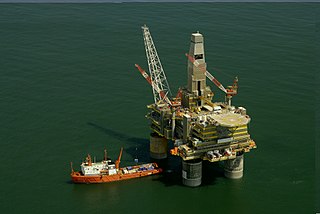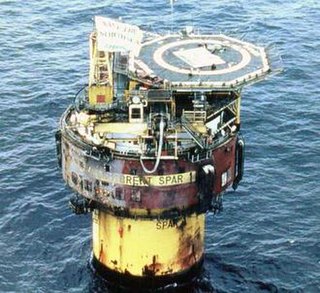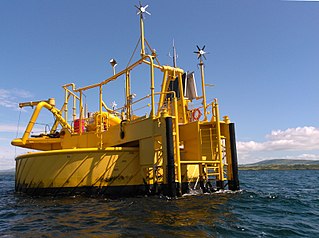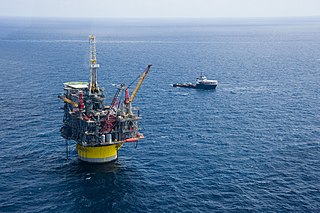
An oil platform is a large structure with facilities to extract and process petroleum and natural gas that lie in rock formations beneath the seabed. Many oil platforms will also have facilities to accommodate the workers, although it is also common to have a separate accommodation platform linked by bridge to the production platform. Most commonly, oil platforms engage in activities on the continental shelf, though they can also be used in lakes, inshore waters, and inland seas. Depending on the circumstances, the platform may be fixed to the ocean floor, consist of an artificial island, or float. In some arrangements the main facility may have storage facilities for the processed oil. Remote subsea wells may also be connected to a platform by flow lines and by umbilical connections. These sub-sea facilities may include one or more subsea wells or manifold centres for multiple wells.

Offshore construction is the installation of structures and facilities in a marine environment, usually for the production and transmission of electricity, oil, gas and other resources. It is also called maritime engineering.

The Troll A platform is a Condeep gravity-based structure offshore natural gas platform in the Troll gas field off the west coast of Norway. Built from reinforced concrete, as of 2014, it was the tallest structure that has ever been moved to another position, relative to the surface of the Earth, and is among the largest and most complex engineering projects in history. The platform was a televised sensation when it was towed into the North Sea in 1995, where it is now operated by Equinor. It is also the heaviest object moved and the object with the second highest displacement at 1.2 million tons(the object with the highest displacement is the Gullfaks C, which had a displacement approaching 1.5 million tons in comparison with Troll A's 1.2 million). Troll A was towed from the afternoon 10 May 1995 until the platform was in place 17 May 1995. It was lowered to the seabed in 303 meters of water, and had penetrated 36 meters into the soil by 19 May 1995. It was self-supporting with no further mooring required.
Petronius is a deepwater compliant tower oil platform built from 1997 to 2000 and operated by Chevron in the Gulf of Mexico, 210 km (130.5 mi) southeast of New Orleans, United States.

A floating production storage and offloading (FPSO) unit is a floating vessel used by the offshore oil and gas industry for the production and processing of hydrocarbons, and for the storage of oil. An FPSO vessel is designed to receive hydrocarbons produced by itself or from nearby platforms or subsea template, process them, and store oil until it can be offloaded onto a tanker or, less frequently, transported through a pipeline. FPSOs are preferred in frontier offshore regions as they are easy to install, and do not require a local pipeline infrastructure to export oil. FPSOs can be a conversion of an oil tanker or can be a vessel built specially for the application. A vessel used only to store oil is referred to as a floating storage and offloading (FSO) vessel.

A tension-leg platform (TLP) or extended tension leg platform (ETLP) is a vertically moored floating structure normally used for the offshore production of oil or gas, and is particularly suited for water depths greater than 300 metres and less than 1500 metres. Use of tension-leg platforms has also been proposed for offshore wind turbines.

The Brent field was an oil and gas field located in the East Shetland Basin of the North Sea, 186 kilometres (116 mi) north-east of Lerwick in the Shetland Islands, Scotland, at a water depth of 140 metres (460 ft). The field operated by Shell UK Limited was discovered in 1971 and was once one of the most productive parts of the UK's offshore assets but has reached the stage where production is no longer economically viable. Decommissioning of the Brent field is complete with the exception of Brent C, which is producing from another field. The discovery well 211/26-1 was drilled in 1971 by the semi-submersible drilling rig "Staflo". This was a major surprise at the time as the nearest land in Scotland and Norway is composed of granite and other non reservoir metamorphic rocks.

Brent Spar, known as Brent "E", was a North Sea oil storage and tanker loading buoy in the Brent oilfield, operated by Shell UK. With the completion of a pipeline connection to the oil terminal at Sullom Voe in Shetland, the storage facility had continued in use, but by 1991, was considered to be of no further value. Brent Spar became an issue of public concern in 1995, when the British government announced its support for Shell's application for its disposal in deep Atlantic waters at North Feni Ridge.

Troll is a natural gas and oil field in the Norwegian sector of the North Sea, one of the biggest in the North Sea, holding 40% of Norway’s gas – it also possesses significant quantities of oil, in thin zones under the gas cap, to the west of the field. The field as a whole consists of the main Troll East and Troll West structures in blocks 31/2, 31/3, 31/5 and 31/6, about 65 kilometres (40 mi) west of Kollsnes, near Bergen. Most of the gas lies in Troll East.

Aasta Hansteen, also known as Hasta Hanseen, was a Norwegian painter, writer, and early feminist.
Sleipner A is a combined accommodations, production and processing offshore platform at the Sleipner East gas field in the Norwegian sector of the North Sea. It is a Condeep-type oil platform, built in Norway by the company Norwegian Contractors for Equinor.

A jackup rig or a self-elevating unit is a type of mobile platform that consists of a buoyant hull fitted with a number of movable legs, capable of raising its hull over the surface of the sea. The buoyant hull enables transportation of the unit and all attached machinery to a desired location. Once on location the hull is raised to the required elevation above the sea surface supported by the sea bed. The legs of such units may be designed to penetrate the sea bed, may be fitted with enlarged sections or footings, or may be attached to a bottom mat. Generally jackup rigs are not self-propelled and rely on tugs or heavy lift ships for transportation.

A spar is a marine structure, used for floating oil/gas platforms. Named after navigation channel Spar buoys, spar platforms were developed as an extreme deepwater alternative to conventional platforms. The deep draft design of spars makes them less affected by wind, wave, and currents and allows for both dry tree and subsea production.

A Single buoy mooring (SrM) is a loading buoy anchored offshore, that serves as a mooring point and interconnect for tankers loading or offloading gas or liquid products. SPMs are the link between geostatic subsea manifold connections and weathervaning tankers. They are capable of handling any tonnage ship, even very large crude carriers (VLCC) where no alternative facility is available.
Offshore concrete structures, or concrete offshore structures, are structures built from reinforced concrete for use in the offshore marine environment. They serve the same purpose as their steel counterparts in oil and gas production and storage. The first concrete oil platform was installed in the North Sea in the Ekofisk oil field in 1973 by Phillips Petroleum, and they have become a significant part of the marine construction industry. Since then at least 47 major concrete offshore structures have been built.
The Hutton oil field, located on the UK continental shelf, was the location for the first ever production Tension Leg Platform (TLP).
The Draupner platform is a gas platform for the extraction of natural gas in the North Sea consisting of the Draupner S and E riser platforms. It is located in the Norwegian North Sea block 16/11 160 km (99 mi) offshore from Norway. The complex consists of seven risers and two riser platforms standing in 70 m (230 ft) water depth and linked by a bridge. Draupner E is the first major oil platform using jacket-type construction supported on a bucket foundation and suction anchors. The complex is owned by Gassled and operated by Gassco. The technical service provider is Equinor.
Heimdal is an offshore natural gas field in the North Sea located 212 kilometres (132 mi) northwest of Stavanger, Norway. Heimdal serves as a connection hub for processing and distribution of natural gas from satellite fields.

Perdido (Spanish for lost) is the deepest floating oil platform in the world at a water depth of about 2,450 meters (8,040 feet) operated by the Shell Oil Company in the Gulf of Mexico. The platform is located in the Perdido fold belt which is a rich discovery of crude oil and natural gas. The Perdido spar began production in 2010 and its peak production is 100,000 barrels of oil equivalent (c. 16000 m3/d) and 200 million cubic feet of gas per day (c. 5.7×106 m3/d).

InterMoor is a global mooring, foundations, and subsea services company. Its services include rig moves, mooring and offshore operations such as engineering and design, survey and positioning, fabrication, subsea installation and chain inspections.













